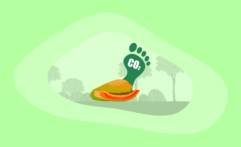The Environmental Impact of Avocados: From Farm to Table
Impactful Ninja is reader-supported. When you buy through links on our site, we may earn an affiliate commission.
Learn more
Learn more
.
Hey fellow impactful ninja ? You may have noticed that Impactful Ninja is all about providing helpful information to make a positive impact on the world and society. And that we love to link back to where we found all the information for each of our posts. Most of these links are informational-based for you to check out their primary sources with one click. But some of these links are so-called "affiliate links" to products that we recommend. First and foremost, because we believe that they add value to you. For example, when we wrote a post about the environmental impact of long showers, we came across an EPA recommendation to use WaterSense showerheads. So we linked to where you can find them. Or, for many of our posts, we also link to our favorite books on that topic so that you can get a much more holistic overview than one single blog post could provide. And when there is an affiliate program for these products, we sign up for it. For example, as Amazon Associates, we earn from qualifying purchases. First, and most importantly, we still only recommend products that we believe add value for you. When you buy something through one of our affiliate links, we may earn a small commission - but at no additional costs to you. And when you buy something through a link that is not an affiliate link, we won’t receive any commission but we’ll still be happy to have helped you. When we find products that we believe add value to you and the seller has an affiliate program, we sign up for it. When you buy something through one of our affiliate links, we may earn a small commission (at no extra costs to you). And at this point in time, all money is reinvested in sharing the most helpful content with you. This includes all operating costs for running this site and the content creation itself. You may have noticed by the way Impactful Ninja is operated that money is not the driving factor behind it. It is a passion project of mine and I love to share helpful information with you to make a positive impact on the world and society. However, it's a project in that I invest a lot of time and also quite some money. Eventually, my dream is to one day turn this passion project into my full-time job and provide even more helpful information. But that's still a long time to go. Stay impactful,Affiliate Disclosure
Why do we add these product links?
What do these affiliate links mean for you?
What do these affiliate links mean for us?
What does this mean for me personally?
![]()
Avocados are a delicious and trendy fruit. They have exploded in popularity over the past few decades, with their US consumption increasing by around 500% between 1985 and 2021. Avocados also have lots of health benefits, including generous helpings of vitamins C+E, as well as magnesium and potassium. They are a classic staple on toast, in salads, and of course, as guacamole. But many steps in the life cycle of avocados can have a serious impact on the environment. So, we had to ask: What is the environmental impact of avocados?
Avocados have a moderately negative impact on the environment. They use nitrogen fertilizer and have moderately high irrigation requirements. They also need a lot of land to grow and use plastic packaging.
In this article, we will examine the environmental impact of avocados from several different angles. We will go through the life-cycle of avocados, detailing their impact on the environment from growth to distribution to your plate to waste management. We will then compare the environmental impact of avocados to that of other fruits. And, finally, we’ll share some tips with you on how you can reduce your own environmental impact and offset your own carbon emissions – both for your personal life and avocados-related.
Here’s How We Assessed the Environmental Impact of Avocados
The Environmental Impact Assessment (EIA) is one of the ways we measure the potential environmental effects of our actions, like the consumption of avocados. It is a holistic assessment based on the environmental changes associated with our consumption. Those are changes in our environment that can have adverse effects on the air, land, water, fish, and wildlife or the inhabitants of the ecosystem.
“Environmental Impact: the effect that the activities of people and businesses have on the environment”
Cambridge Dictionary
Basically, all goods and services you buy – including avocados – leave an impact on our environment. When it comes to food in general, and avocados in specific, the following are key factors:
- Land requirements: Large parts of the world that were once covered by forests and wildlands are now used for agriculture. 10 million hectares of forest are destroyed annually and 50% of the world’s habitable land is now used for agriculture. This loss of natural habitat has been the main driver for reducing the world’s biodiversity.
- Water footprint: 70% of global freshwater is now used for agricultural purposes. By assessing the water footprint of a particular food, we can determine how our limited freshwater resources are being consumed and polluted.
- Pesticide and fertilizer usage: Pesticides and fertilizers provide a range of agricultural benefits. However, numerous studies link pesticides and fertilizers to serious effects on human health, along with disruptions to vital ecosystems and the spread of aquatic dead zones.
- Carbon footprint: The carbon footprint is one of the ways we measure the effects of our human-induced global climate change. Today, food production accounts for over a quarter (26%) of global greenhouse gas emissions.
- Waste generation: Food and its packaging account for almost 45% of the materials landfilled in the US alone. And packaging sent to landfills, especially when made from plastics, does not degrade quickly or, in some cases, at all.
To understand the overall environmental impact of avocados, we must assess each of their key factors. This Environmental Impact Assessment (EIA) is a tool originally developed to identify the environmental impacts of a project prior to decision-making and also helps us to evaluate the environmental impacts of avocados, from farm to table.
Here’s the Overall Environmental Impact of Avocados
The overall environmental impact of avocados is moderately negative. The main factors behind this are nitrogen fertilizer use, moderately high irrigation requirements, low land yield, monoculture farming practices, and waste mismanagement.
Avocado production has some eco-friendly components. For example, they use very few pesticides and use cardboard packaging which has a high recycling rate. However, there are still many aspects of their production that are more harmful to the environment.
So, let’s have a look at the environmental impact of each key factor of avocados!
| Key Assessment Factors | Environmental Impact |
| Land requirements for avocados | Avocados have a low land yield and are grown in monocultures. Thus, they have a fairly negative impact on the environment at this stage. |
| Water footprint of avocados | Avocados have a moderate water footprint of about 50 inches of water per year. They require a significant amount of irrigation, yet need very little water to clear up pesticide runoff. |
| Agrochemical usage for avocados | Avocado agrochemical use is moderate. They use few pesticides, but they also use harmful nitrogen fertilizer. |
| Carbon footprint of avocados | Avocados have a high carbon footprint at around 0.85kg (1.9lbs) of CO2e per pound of avocados. The main reasons for this are transportation emissions, deforestation due to high land use, waste management, and significant water consumption. |
| Waste generation of avocados | Avocados waste generation is fairly high. Most of their waste, both organic and packaging, ends up in landfills so their environmental impact is fairly negative at this stage. |
These are the overall summaries, but there is a lot more to the story. In the next few sections, we will dive deeper into each stage to illustrate all the important aspects of avocados’ environmental impact.
What Are the Land Requirements for Avocados
Avocados have a low land yield and are grown in monocultures. Thus, they have a fairly negative impact on the environment at this stage.
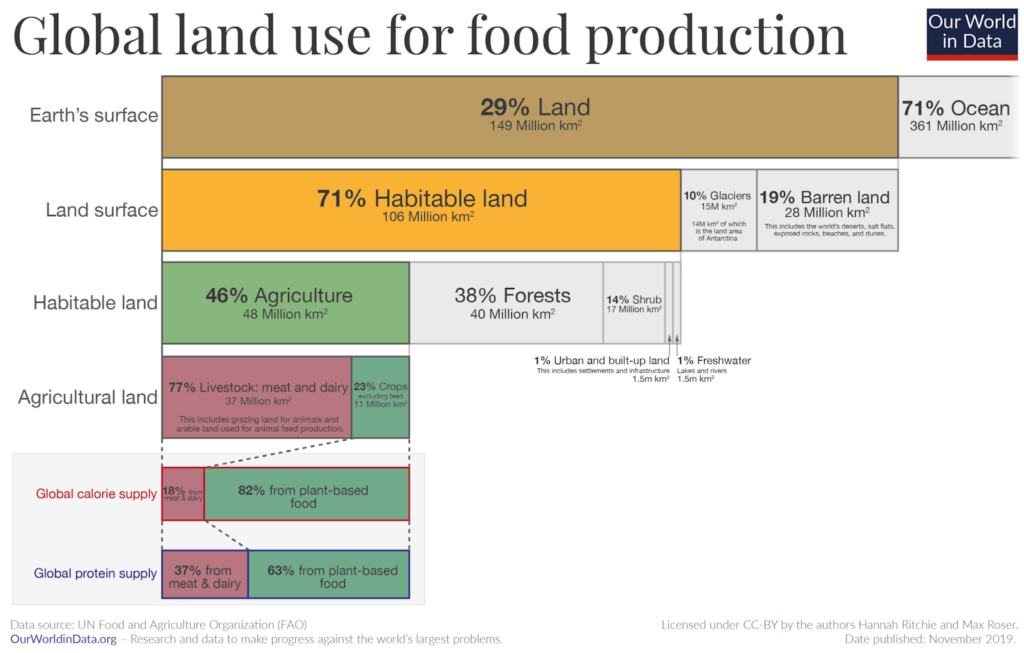
Growing avocados has a lot of variables that contribute to their environmental impact. The amount of land they use, the way in which they grow, and the amount of time they take to grow will all contribute to their environmental impact.
How do the land requirements of avocados impact their environmental footprint?
- What is the land usage of avocados: Avocados yield around 7–13 tons per hectare. This is on the lower end of yields for fruit, which means avocados will need more resources per pound to grow. For example, bananas yield around 100 tons per hectare. The land usage of avocados has a moderately negative environmental impact.
- Where and how are avocados grown: Avocados are grown on trees. Trees have natural carbon sequestration properties and so some of avocados’ environmental impact is offset by this. However, avocado trees are also grown in monocultures. Monocultures are harmful to the environment as they reduce biodiversity and can harm soil microbes. Therefore, avocado trees’ use of monoculture has a negative environmental impact, despite the fact that they sequester carbon.
- How does the avocado industry affect the loss of habitable land: With the high number of avocados produced every year, a lot of land is used to grow them. An average of 1700 acres are cleared for avocado use every year. Much of this deforestation in Mexico is achieved through a loophole that allows agriculture to take over burned forests. Corporations will intentionally burn forests to bypass deforestation laws and grow avocados.
- How does the avocado industry affect wildlife and biodiversity: Avocados’ use of monoculture planting means that their vast farms negatively affect biodiversity. Wildlife that lives in previously biodiverse regions will have little to thrive on in a monoculture environment. For example, deforestation has caused longer, more severe hot weather spells which have affected the migration patterns of the endangered Monarch butterfly.
In short, the environmental impact of avocado land requirements is fairly negative. The main factors contributing to this are monoculture growing practices, long growth duration, and high land use.
What Is the Water Footprint of Avocados
Avocados have a moderate water footprint of about 50 inches of water per year. They require a significant amount of irrigation, yet need very little water to clear up pesticide runoff.
Avocados have a moderate water footprint. Water usage is one of the most important factors in the environmental impact of a fruit. The amount of water used, as well as the way they affect the water sources around them, are all major contributing factors. Here, we will look at these different angles to avocados’ water impact.
How does the water footprint of avocados impact their environmental footprint?
- What is the overall water usage of avocados: Avocado trees need around 50 inches of water per year. This works out to be around 15 gallons of water per fruit over the course of its lifetime. This is a fairly average water requirement amongst fruits.
- What is the green water footprint of avocados: The green water footprint is the amount of water from precipitation stored in the soil and used by plants for growth. Most avocados consumed in the US are grown in Mexico. Mexico gets around 28 inches of rain per year. This means that just over half of avocados’ 50 inch per year requirement is covered by rainfall. The rest is covered by irrigation.
- What is the blue water footprint of avocados: The blue water footprint is the amount of water sourced from surface (such as rivers or lakes) or groundwater resources. Since only 28 of the 50 inches per year required for avocado trees come from rainfall, the remaining 22 inches need to come from irrigation. Irrigation has a negative impact on the environment, with a high carbon footprint and significant modification of groundwater balance. So, the environmental impact of avocados at this stage is fairly negative.
- What is the gray water footprint of avocados: The gray water footprint is the amount of freshwater required to clean up water pollution to meet certain quality standards. Essentially, it’s the amount of water needed to make polluted water clean enough to be safe and healthy for humans and the environment. Avocados have very low pesticide use and so their impact at this stage is low.
- How does the avocado industry affect freshwater and ocean pollution: Avocados have low agrochemical use and so they don’t affect the water in this way. However, the fact that they use plastic packaging means that they can have a severe effect on ocean life.
In short, the significant irrigation requirements of avocados means that their environmental impact at this stage is fairly negative. However, their use of pesticides is generally low.
What Is the Agrochemical Usage for Avocados
Avocado agrochemical use is moderate. They use few pesticides, but they also use harmful nitrogen fertilizer.
Pesticides and fertilizers can have a significant impact on the environment. They both require resources to create as well as have effects on the life around them. Here, we will look at how avocados’ pesticide and fertilizer rates affect their environmental impact.
How does the pesticide and fertilizer usage of avocados impact their environmental footprint?
- What is the pesticide usage of avocados: Avocados were rated first on a list of foods with the lowest pesticides. This means that the negative environmental effects of pesticides, such as groundwater and wildlife disruption, are very low for avocados.
- What is the fertilizer usage of avocados: Avocados typically need to be fertilized with nitrogen. Nitrogen has a negative environmental impact. Therefore the fertilizer use of avocados contributes significantly to its overall environmental impact.
- Are there any known issues connected to the agrochemical usage for avocados: Avocados’ use of nitrogen fertilizers has significant issues. Namely, these fertilizers have high carbon emissions and can affect groundwater sources.
In short, avocados’ use of nitrogen fertilizer means their environmental impact at this stage is moderately negative.
What Is the Carbon Footprint of Avocados
Avocados have a high carbon footprint at around 0.85kg (1.9lbs) of CO2e per pound of avocados. The main reasons for this are transportation emissions, deforestation due to high land use, waste management, and significant water consumption.
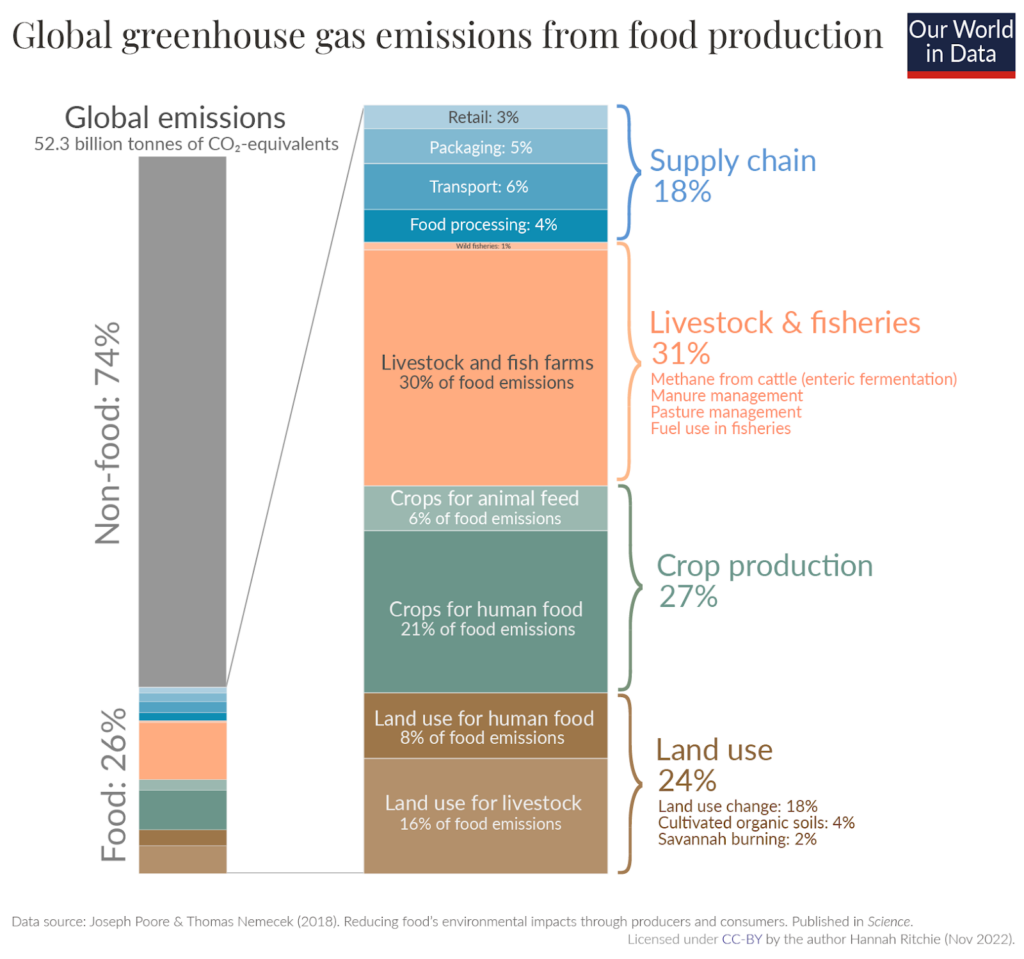
Carbon footprint is one aspect of the overall environmental impact of a fruit. It essentially measures how much carbon or other greenhouse gasses the production of avocados emits into the atmosphere. Emissions from product manufacturing, irrigation, transportation fuel, and landfills all add up to create the overall carbon footprint of a fruit. Let’s see how the carbon footprint of avocados breaks down and contributes to their environmental impact.
How does the carbon footprint of avocados impact their environmental footprint?
- What is the overall carbon footprint of avocados: The overall carbon footprint of avocados is around 0.85 kg (1.9 lbs) of CO2e per pound of avocados. This is one of the highest carbon footprints among fruits.
- What are the main contributors to the carbon footprint of avocados: The main contributing factors to avocados’ high carbon footprint are their high transportation distances, high water use, and mismanagement of waste.
- Which life-cycle stage of avocados has the highest carbon footprint: The life-cycle stage with the highest impact on avocados environmental impact is transportation. Most avocados come from Mexico and are transported to the US in refrigerated trucks.
In short, avocados’ use of water, high-carbon transportation methods, and lack of composting and recycling result in one of the highest carbon footprints among fruit.
What Is the Waste Generation of Avocados
Avocados waste generation is fairly high. Most of their waste, both organic and packaging, ends up in landfills so their environmental impact is fairly negative at this stage.
When fruit waste, either packaging or organic materials, is disposed of, they can have a major impact on the environment. Whether it’s damaging wildlife, getting into oceans, emitting methane, or dissolving into microplastics that contaminate groundwater, all these materials have their part to play. In this section, we will look at how avocado waste affects the environment.
How does the waste generation of avocados impact their environmental footprint?
- What is the packaging of avocados: Avocados are mainly packaged using cardboard and plastic. Plastic has devastating consequences on the environment. For example, it negatively affects ocean life, emits greenhouse gasses in its creation, and creates toxic microplastics that get into groundwater and food. Cardboard, though better than plastic, still contributes to deforestation which also has a negative environmental impact.
- How is the packaging of avocados disposed of: Both cardboard and plastic can be recycled, but their recycling rates vary. On the one hand, cardboard has a very high recycling rate of 89%. Whereas, plastic has a recycling rate of around 9%. When plastic and cardboard are not recycled, they end up in landfills, which have many adverse effects on the environment, including carbon emissions, soil pollution, and damage to wildlife. So, the plastic components of avocado packaging will have a much more negative environmental impact than cardboard in their disposal.
- How are avocados disposed of: Avocados have pits and peels that aren’t eaten. These can technically be composted, but composting rates are generally low amongst food waste, at around 4%. Therefore, most avocado waste ends up in landfills. Besides the general adverse environmental effects of landfills, food waste has a particularly negative effect on the environment when put into landfills. This is because food waste releases methane, a harmful greenhouse gas. Avocado waste, then, has a negative environmental impact.
In short, the use of plastic packaging and lack of composting efforts means that avocados have a fairly negative waste impact.
What Have Been Historical Environmental Issues Connected to the Avocado Industry
Avocados have partaken in some farming practices that have harmed the environment a lot over the years. These include the destruction of Mexican forests, damage to aquatic life from plastic, and habitat loss.
All fruits have had a complex road toward global distribution. They originate in one part of the world and often travel far to end up in your local supermarket. From farm to table, some of our favorite fruits have racked up some serious environmental damage along the way. Whether it’s deforestation to meet demand, water pollution, or disruption of wildlife, most fruits have left a path of destruction. Let’s see how avocados have fared throughout history.
What have been the key historical environmental issues of the avocado industry?
- How much land has been lost because of avocado production: The US opened their borders to Mexican avocados in 1997, which greatly increased demand for the fruit. Mexico also changed land laws in 1992, allowing for more agriculture. Over the next 16 years, they lost over a third of their forests to agricultural production.
- Which wildlife species have been negatively impacted or displaced because of avocado production: Many Mexican species have experienced habitat loss because of avocado farming’s deforestation. For example, jaguars became endangered partially due to agricultural deforestation in Mexico. Habitat loss remains the leading cause of endangered animals worldwide.
- Have water sources and soil been contaminated because of avocado production: Nitrogen fertilizers used in avocado farming have harmed soil and groundwater. Plastic is also used in avocado packaging, which has become a big contributor to water pollution.
In short, avocados have a fairly negative track record when it comes to their historical environmental impact. Many of their impacts have caused permanent damage to land, wildlife, and water sources.
What Is the Overall Environmental Impact of Food and Agriculture
Food production in general has a high environmental impact. Everything from the amount of land used to the energy involved in irrigation to its effect on plant and animal biodiversity can be a factor in this. In the chart below, you can see how food production is one of the biggest influences on these areas of the environment.
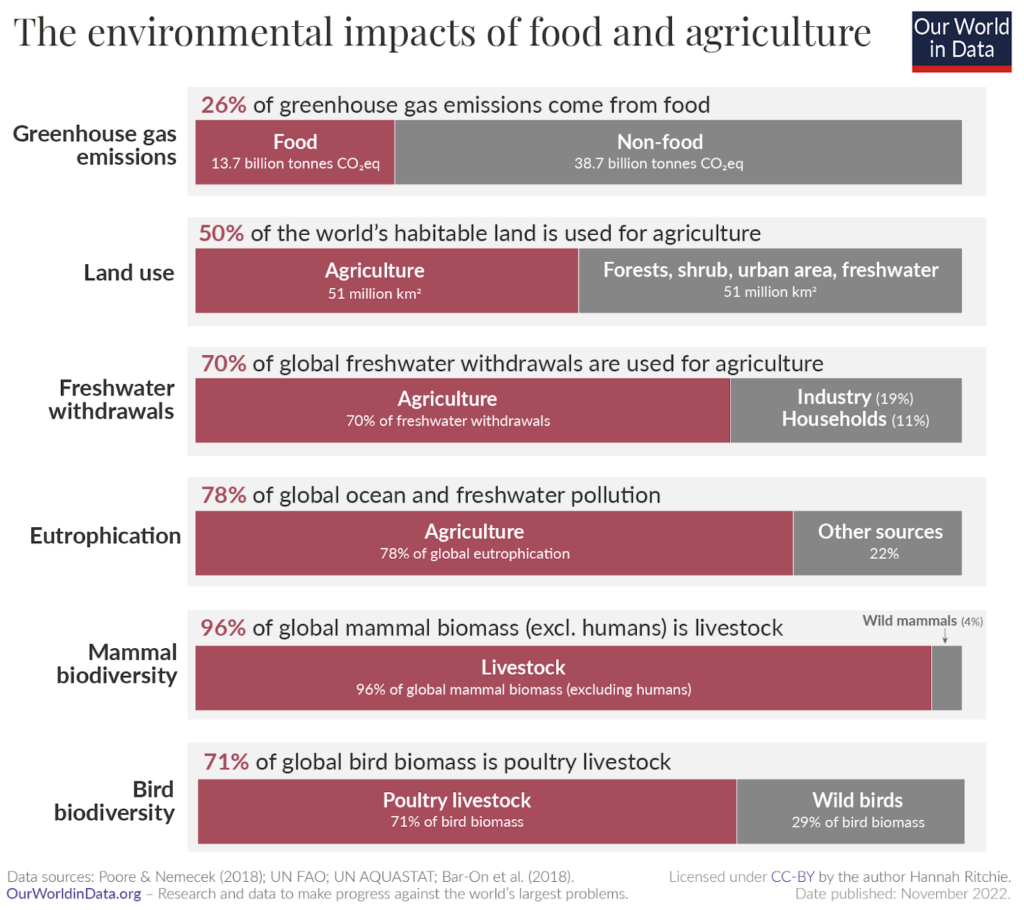
Agriculture alone accounts for over a quarter of global greenhouse gas emissions, while using half of the world’s habitable land and 70% of the global freshwater withdrawals. Agriculture also causes 78% of the global ocean and freshwater pollution.
Livestock accounts for the vast majority of non-human mammal and bird biomass. Mammal livestock outweighs wild mammals by a factor of 15-to-1, and poultry livestock outweighs wild birds by a factor of more than 3-to-1.
These statistics highlight the need for sustainable and responsible practices in food production to reduce its impact on the environment. And the need for us to shift toward more environmentally-friendly foods.
How Can You Reduce Your Environmental Impact and Offset Your Personal Carbon Footprint
There are a few things you can do to mitigate some of the negative environmental effects of consuming avocados, while still enjoying them. You can also consider offsetting your personal and avocados-related carbon emissions, which work to remove carbon emissions elsewhere that are then attributed to you. Here, we will walk you through how to accomplish both of these things.
How Can You Reduce Your Environmental Impact When Shopping for Avocados
In this section, we give you a short list of ways you can reduce the negative environmental effects of avocados, based on those parts of the life-cycle of avocados that would otherwise most negatively impact the environment:
- Buy unpackaged avocados: A major factor in the environmental impact of an avocado is the packaging. If you buy avocados loose, without any plastic, styrofoam, or cardboard, then your overall waste will be much lower, thus reducing the amount of harmful waste in landfills.
- Recycle and compost avocado waste: If you do buy packaged avocados, try to recycle any packaging to avoid contributing to landfills. You can also compost the pits and skins so they don’t end up in landfills either. If your city doesn’t have a municipal composting service, consider creating one of your own!
- Buy domestic avocados: One of the biggest contributors to environmental impact is carbon footprint, which is greatly influenced by transportation distances. If you try to buy avocados that are grown in California or Florida, then you will be cutting down on the emissions from the trucks that deliver them.
- Buy Florida avocados: Irrigation has a major part to play in avocados’ negative environmental impact. Besides being in the US, avocados from Florida require less irrigation. This is because Florida has a higher average rainfall than many other places where avocados are grown. It gets around 54 inches of rain per year, which covers avocados’ water needs. Buying avocados from Florida will thus reduce irrigation and lessen your avocados’ negative environmental impact.
Following some of these methods can really help you to cut down on your environmental impact of eating avocados. None of these will completely eradicate these negative impacts, since there are always effects that may be outside of your control. But some reduction is always better than nothing!
How Can You Offset Your Personal Carbon Footprint
The carbon footprint is a key part of your environmental impact. And it is one of the ways we measure the effects of our human-induced global climate change. Yes, even from eating avocados!
“Carbon footprint: the amount of greenhouse gases and specifically carbon dioxide emitted by something (such as a person’s activities or a product’s manufacture and transport) during a given period”
Merriam Webster
Basically, it is the amount of carbon emitted by you as an individual or an organization providing you with goods and services – including avocados:
- This includes GHG emissions from producing the products that we use and foods that we eat (e.g., power plants, factories or farms, and landfills)
- GHG emissions from fuel that we burn directly or indirectly (e.g., logistics and transportation, cooling or heating facilities),
- as well as the GHG emissions attributed to how we consume these products and foods.
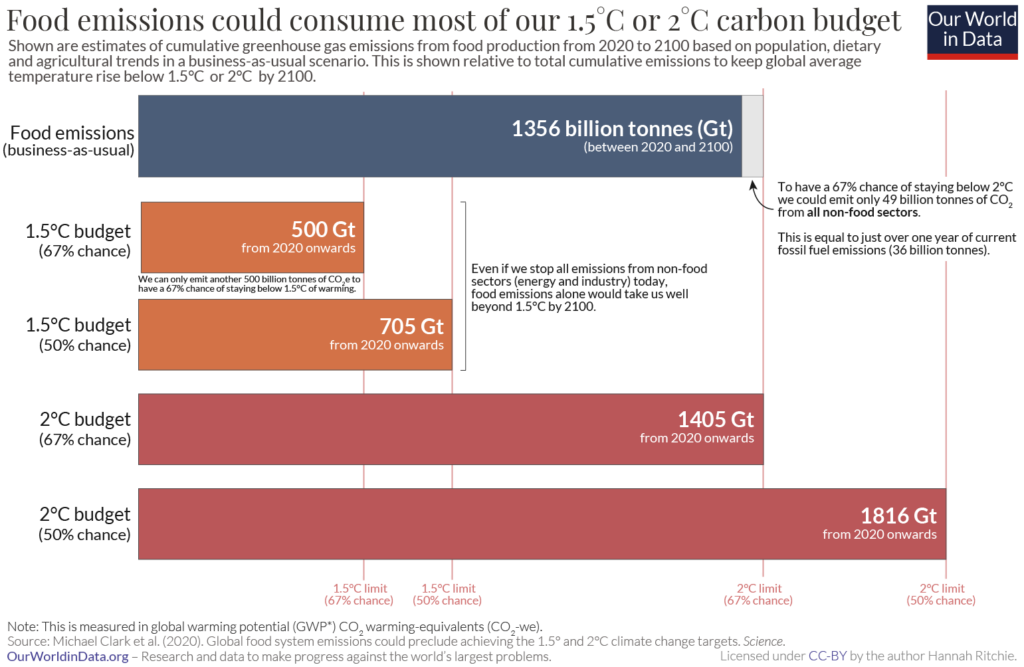
Carbon offsets are reductions in carbon emissions that are used to compensate for carbon emissions occurring elsewhere – for example for the carbon emissions that are associated with avocados. They are measured in tons of CO2 equivalents and are bought and sold through international brokers, online retailers, and trading platforms on what is known as the global carbon offset market.
“Carbon Offset: a way for a company or person to reduce the level of carbon dioxide for which they are responsible by paying money to a company that works to reduce the total amount produced in the world, for example by planting trees”
Oxford Dictionary
In terms of avocados – and indeed all food types – there will always be a carbon footprint, because of the resources it takes to get your food from farms to the place where you’ll eventually eat them. And while there are ways to reduce your carbon footprint when shopping for avocados, carbon offsets would be a way to reduce your CO2e emissions all the way down to net zero (or even to become climate positive).
However, when you purchase carbon offsets, it’s important that they actually make a difference in offsetting (aka reducing) total carbon emissions. To achieve that, the following are key criteria:
- Carbon offset projects have to be effective (different projects have different effectiveness rates)
- Carbon offset projects have to be additional
- Carbon offset projects have to be permanent
- The claims from carbon offset projects have to be verifiable
To find the best carbon offsets for you personally, check out our full guide on the best carbon offsets for individuals, where you’ll also learn more about how these carbon offset projects work, what their respective offsetting costs are, and what your best way would be to offset your own carbon emissions.
Final Thoughts
Avocados have a lot of room for improvement when it comes to environmental impact. They use harmful fertilizers, farm in monocultures, and use plastic packaging. However, there are also a lot of ways in which you can reduce your impact through avocado consumption. Buying local avocados and mitigating your packaging consumption are both great places to start. If you follow some of these steps, you can greatly reduce the negative environmental impact your avocado consumption has on the environment.
Stay impactful,

Sources
- Statistica: Average Avocado Consumption in the US
- Medical News: 12 Health Benefits of Avocado
- Cookie and Kate: Avocado Toast Recipe
- Cooking Classy: Avocado Salad
- Simply Recipes: Perfect Guacamole
- UN Environment Programme: Environmental Impact Assessment and Strategic Environmental Assessment: Towards an Integrated Approach
- Our World in Data: The environmental impacts of food and agriculture
- Our World in Data: Global land use for food production
- World Health Organization: Preventing disease through healthy environments: a global assessment of the burden of disease from environmental risks
- ScienceDirect (Biological Conservation): Worldwide decline of the entomofauna: A review of its drivers
- EPA: The Sources and Solutions: Agriculture
- EPA: Reducing Food Waste and Packaging
- FoodPrint: The Environmental Impact of Food Packaging
- Impactful Ninja: What is the Carbon Footprint of Avocados
- Wikifarmer: Avocado Harvest Yield Per Hectare
- Impactful Ninja: What is the Carbon Footprint of Bananas
- Good Housekeeping: How to Grow an Avocado Tree
- Woodland Trust: How Trees Capture and Store Carbon
- You Matter: Avocado Sustainability
- EOS: Monoculture Farming Explained
- Alva Water: Are Avocados Green?
- WeForum: The “Green Gold” Causing Environmental Havoc
- RHS: Avocados
- Colostate: Avocados
- Impactful Ninja: What is the Carbon Footprint of Strawberries
- Wikifarmer: Avocado Tree Water Requirements
- Fair Observer: Green Gold: The Curse of the Avocado
- Water Footprint: What is a Water Footprint?
- USDA: Imports Play a Dominant Role in US Demand for Avocados
- Climate Knowledge Portal: Mexico
- Science Direct: Energy and Carbon Footprint of Irrigation
- World Atlas: What is the Environmental Impact of Irrigation
- Healthline: The Clean Fifteen
- Wikifarmer: Avocado Harvest
- Biological Diversity: The Plastic Production Problem
- USGS: Pesticides in Groundwater
- GOV.BC: Environmental Protection and Pesticides
- UCANR: Managing Pests in Gardens
- Mitsui: Reducing the Environmental Impact of Garden Fertilizers
- Our World in Data: Global greenhouse gas emissions from food production
- Estimating the Water and Carbon Footprint of Growing Avocados
- USDA: Protecting Perishable Foods
- Wikifarmer: Avocado Harvest Yield Per Hectare
- Biological Diversity: The Plastic-Production Problem
- Teorra: What is the Carbon Footprint of Packaging
- UNEP: Plastic Planet: How Tiny Plastic Particles are Polluting Our Soil
- TRVST: Environmental Impact of Cardboard
- Also Known As: 12 Interesting Facts About Packaging
- SL Recycling Ltd: What Are the Negative Effects of Landfill
- EPA: Reducing the Impact of Wasted Food
- GOV.BC: Waste Management
- ResearchGate: Land Use and Land Tenure Changes in Mexico’s Avocado Production
- Biological Diversity: Mexico’s Ten Most Iconic Endangered Species
- NWF: Habitat Loss
- Our World in Data: The environmental impacts of food and agriculture
- Earth Easy: Composting
- EDIS: Avocado Growing in Florida
- Weather Stem: Annual Precipitation: Florida
- Our World in Data: Emissions from food alone would take us past 1.5°C or 2°C this century
- Impactful Ninja: Why Is a Carbon Footprint Bad for the Environment
- Impactful Ninja: Best Carbon Offsets for Individuals

